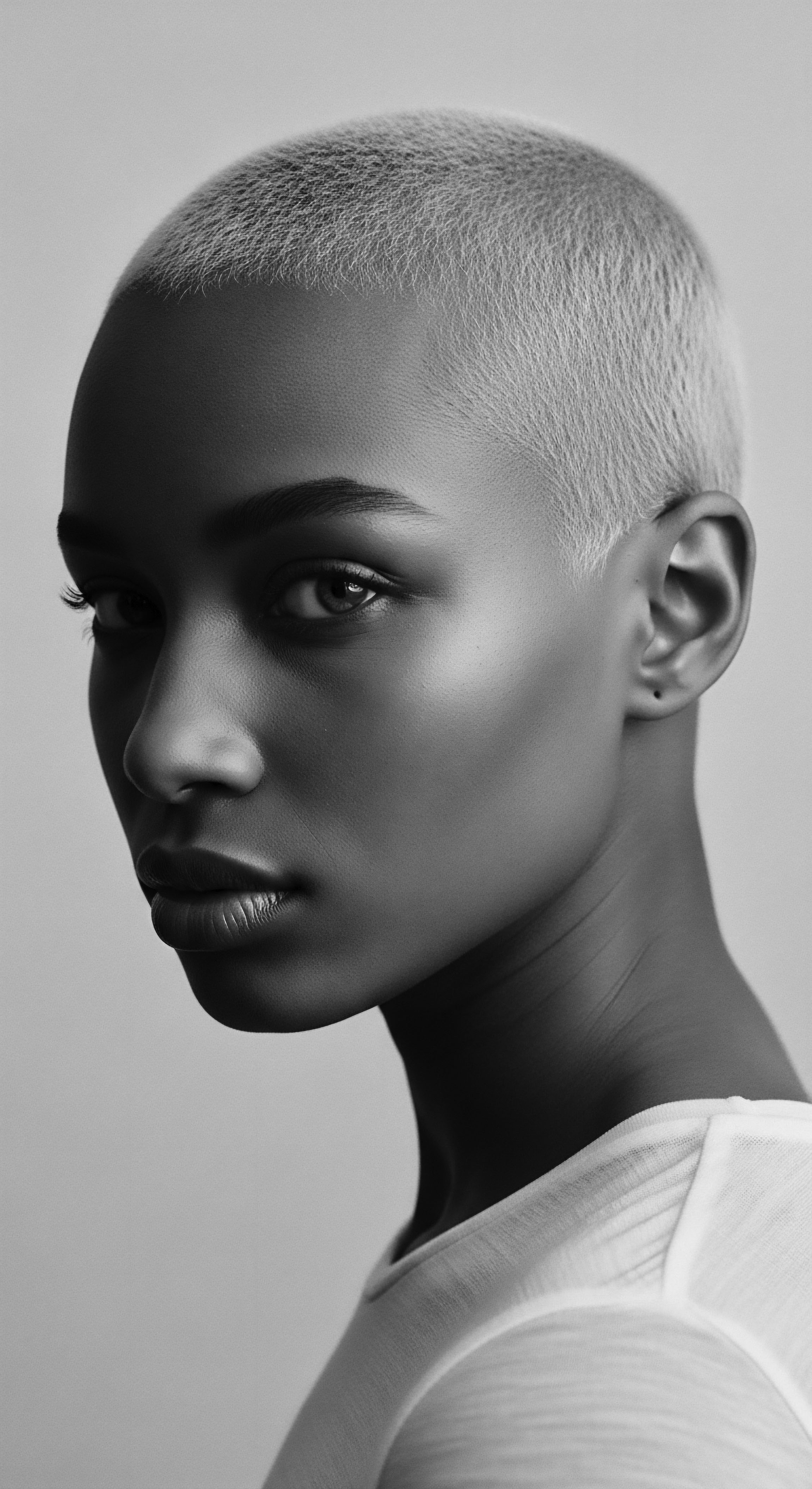
Fundamentals
The conversation surrounding hair care, particularly for textured hair, finds itself often at the crossroads of scientific discovery and ancestral knowledge. Amidst the myriad of ingredients that grace our modern formulations, a select few carry the echoes of generations past, whispering tales of wisdom passed down through time. One such revered botanical ally, a truly remarkable gift from the earth, stands as a testament to the enduring understanding our forebears held regarding natural remedies ❉ the venerable Slippery Elm.
To truly grasp the foundational benefits of slippery elm, we must first allow ourselves to journey back to its very being, its elemental biology. Its name, Ulmus Rubra, speaks to its reddish inner bark, the heart of its potency. What makes this inner bark so extraordinary, so deeply valuable for hair, is its inherent ability to produce a unique, viscous substance known as Mucilage. This isn’t just any plant exudate; it is a complex polysaccharide, a natural polymer with an astonishing capacity to hydrate and coat.
When the inner bark encounters water, this mucilage swells, transforming into a gelatinous elixir. This fundamental characteristic, this wondrous mucilaginous property, stands as the bedrock of its meaning and significance in hair care.
Our ancestors, those tender caretakers of the strands that adorned their crowns, perceived this physical property with an intuitive wisdom that predates modern laboratories. They observed how this inner bark, when soaked, offered a palpable Slip and a calming feel. This sensory understanding, born from observation and sustained by practice, formed the earliest interpretation of its benefits.
For textured hair, which often craves moisture and detangling ease, this intrinsic quality of slippery elm acts as a balm. It allows for a gentle unraveling of coils and curls, reducing friction and preserving the delicate integrity of each strand.
Slippery elm’s fundamental benefit for hair care stems from its mucilaginous inner bark, a natural polymer offering exceptional slip and hydration.
The plant’s designation, its very identity within indigenous pharmacopeias, reflects this practical application. Across various Indigenous nations in North America, where the slippery elm tree makes its home, its inner bark was a versatile component of daily life and healing. The benefits, at their simplest, manifest as a profound capacity to soothe and protect.
Imagine hands, practiced and knowing, preparing this bark, feeling its transformation, and applying it to distressed skin or perhaps to hair that had known the harshness of sun and wind. This direct experience forged the initial understanding of its soothing power.
The elucidation of slippery elm’s qualities begins with this basic appreciation for its inherent moistening and calming attributes. Its ability to create a smooth, protective layer stands as a primary aspect of its efficacy. This simple yet powerful mechanism explains why it became, and remains, a cherished element in natural wellness, particularly for those seeking a gentle, effective care for hair that honor traditions of elemental healing. The journey of understanding slippery elm’s worth starts here, at the very root of its botanical generosity.

Intermediate
Moving beyond the initial grasp of slippery elm’s inherent qualities, an intermediate understanding deepens, weaving together its scientific attributes with the rich tapestry of human experience and ancestral practices. The meaning of Slippery Elm Benefits expands here to encompass its historical role as a versatile botanical, particularly for its emollient and demulcent actions, properties that found resonant purpose in hair care traditions across generations. This plant, Ulmus Rubra, carried a profound significance for its capacity to offer comfort and protection, a wisdom not confined to one ailment but broadly applied to foster wellbeing.
The mucilage, that remarkable swelling agent within the inner bark, acts as a humectant, drawing moisture from the environment and binding it to the hair shaft. This capacity to retain moisture holds profound implications for textured hair, which, by its very coiled and spiraled structure, finds it challenging for natural oils to travel down the length of the strand. This often results in a proclivity toward dryness, a fundamental challenge that ancestral practices sought to mitigate. Slippery elm, with its moistening prowess, offered an ingenious solution.
The traditional uses, often recorded in ethnobotanical studies, speak to its application not just internally, but externally, for various soothing purposes. For instance, the demulcent and emollient properties of slippery elm bark were widely recognized for their capacity to soothe and promote healing for skin irritations. While direct historical records of explicit “hair conditioner” recipes may be less common in early texts, the continuous application of mucilaginous plants for general topical soothing and softening points to a deep, intuitive understanding of their value for scalp and hair health.
Ancestral applications of slippery elm for soothing and softening illustrate an early intuitive grasp of its benefits for hair, particularly its moisture-retaining mucilage.
Consider the ancestral context ❉ daily life often exposed hair to harsh elements – sun, dust, and laborious activities. The hair, a symbol of identity and strength in many cultures, would have required consistent, gentle care to maintain its vitality. Slippery elm’s inclusion in general topical applications suggests its role in alleviating dryness, mitigating tangles, and promoting a softer, more manageable texture. The practice of using such a resource, abundant in its native North American lands, reflects a profound connection to the immediate environment and a thoughtful utilization of available botanical treasures.
This shared ancestral knowledge, particularly among Indigenous communities, provides a rich backdrop for understanding the contemporary appreciation of slippery elm benefits. Its gentle efficacy meant it was a trusted ally for generations. Its capacity to reduce friction during detangling, its inherent ability to coat and protect the individual hair strands, and its calming influence on an irritated scalp collectively contribute to its enduring value. The interpretation of its benefits, therefore, moves beyond mere observation to an appreciation of its holistic contribution to hair resilience and vibrance, rooted deeply in communal wisdom.

Ancestral Adaptations of Slippery Elm
The foresight of ancestral healers and caregivers, a wisdom often overlooked in the swift march of modern innovations, saw profound utility in plants like slippery elm. These communities, living in intimate relationship with their natural surroundings, adapted plant properties to suit a myriad of needs. The very same mucilaginous quality that soothed an irritated throat or aided digestion, they recognized, possessed a similar capacity for external application.
- Soothing Poultices ❉ Ancestral practices frequently involved creating poultices from the inner bark, which would be applied to wounds, burns, or inflamed skin. This demonstrates a deep understanding of its protective and healing actions, qualities directly transferable to an irritated scalp.
- Emollient Washes ❉ While not always explicitly termed for hair, washes prepared from slippery elm bark would have offered softening properties, aiding in the management of coarse or dry hair, a common characteristic of many textured hair types.
- Lubricating Aids ❉ The remarkable Slip provided by slippery elm’s mucilage would have been intuitively valuable for detangling hair that could easily snarl and knot, preventing breakage that might otherwise occur during styling or daily care.
These historical applications, though varied, share a common thread ❉ the profound appreciation for slippery elm’s capacity to lubricate, protect, and soften. This historical lens allows us to see how the very elements cherished by our ancestors for general well-being laid the groundwork for its celebrated status in contemporary natural hair care. The plant’s historical designation truly reflects its enduring significance.
| Aspect of Benefit Detangling & Slip |
| Ancestral Understanding / Use Intuitive recognition of 'slippery' texture aiding in managing unruly fibers. |
| Modern Hair Science Connection Polysaccharides in mucilage provide a low-friction surface, reducing mechanical damage during detangling. |
| Aspect of Benefit Moisture Retention |
| Ancestral Understanding / Use Observation of moistening effect on dry tissues; likely extended to hair. |
| Modern Hair Science Connection Humectant properties attract and seal moisture into the hair cuticle, combating dryness inherent to textured strands. |
| Aspect of Benefit Scalp Soothing |
| Ancestral Understanding / Use Application of poultices for skin irritations, which could extend to scalp discomfort. |
| Modern Hair Science Connection Anti-inflammatory and demulcent compounds calm scalp irritation, reducing itching and flaking. |
| Aspect of Benefit The enduring utility of slippery elm reveals a continuous thread of wisdom, spanning from ancient botanical appreciation to contemporary scientific validation for textured hair care. |

Academic
At the academic stratum, the meaning of Slippery Elm Benefits transcends anecdotal accounts, rooting itself in rigorous scientific scrutiny and ethnobotanical analysis, while persistently upholding its deep connection to textured hair heritage and ancestral practices. The elucidation here hinges on a comprehensive understanding of Ulmus Rubra, particularly the complex biochemical composition of its inner bark’s mucilage and the profound implications of its physicochemical properties for the nuanced care of highly structured hair types. This is where the wisdom of ancestral knowledge finds its compelling affirmation through contemporary research, forging a bridge between epochs of understanding.
The academic definition centers on the inner bark’s rich content of polysaccharides, primarily galacturonic acid, galactose, and rhamnose, which collectively form the mucilaginous hydrocolloid. This intricate polymeric structure, when hydrated, exhibits extraordinary rheological properties, specifically a high viscosity and remarkable lubricity. For textured hair, characterized by its unique coiling, kinking, and waving patterns, these properties are not merely beneficial; they are foundational to mitigating common challenges such as mechanical breakage, dryness, and entanglement. The polysaccharides create a protective, occlusive film around the hair shaft, effectively sealing in moisture and reducing the coefficient of friction between individual strands, thereby facilitating effortless detangling and minimizing tensile stress during manipulation.
Academic understanding of slippery elm benefits unveils a complex interplay of polysaccharides that provides critical moisture retention and frictional reduction for textured hair.

Ethnobotanical Underpinnings and Diasporic Relevance
The historical narrative of slippery elm, particularly its extensive use by various Indigenous nations across its native Eastern North America, provides a compelling academic lens through which to comprehend its enduring relevance. Its designation, often as ‘Indian elm’ or ‘moose elm’, reflects generations of observation and practical application. Traditional knowledge systems, often passed down orally, recognized the plant’s soothing and binding qualities for diverse physiological needs. While explicit hair care manuals from these periods are rare, the application of mucilaginous plants for general topical ailments, including skin irritations and wound healing, establishes a powerful precedent for its intuitive use on the scalp and hair.
Daniel E. Moerman, in his seminal work, Native American Ethnobotany, meticulously documents the widespread utilization of Ulmus rubra for its demulcent properties, noting its application in poultices for soothing skin, burns, and wounds . This broad application of its emollient nature suggests a holistic view of bodily care, where a substance that could calm skin inflammation could also be instinctively applied to an irritated scalp or used to soften hair that was prone to dryness and brittleness. This deeply ingrained understanding of plant pharmacology, albeit without modern chemical nomenclature, speaks volumes about ancestral ingenuity.
For communities within the Black diaspora, whose ancestral care practices often involved ingenious adaptations of available resources, this inherited wisdom regarding mucilaginous plants—whether through direct lineage or cultural exchange—remains profoundly significant. The properties of slippery elm would have resonated with the inherent needs of their hair textures, which often suffer under conditions of dryness and mechanical stress. The ability to create a ‘slip’ for detangling was not a mere convenience; it was a critical strategy for minimizing breakage and preserving hair length, qualities that held immense cultural value and were often linked to concepts of beauty, strength, and resilience amidst challenging socio-historical contexts. The transfer of knowledge, albeit sometimes through fraught historical pathways, meant that the benefits of plants like slippery elm could be integrated into diverse hair care rituals, solidifying its place as a venerated ingredient.

Biophysical Impact on Textured Hair
From a biophysical standpoint, the polysaccharides in slippery elm mucilage form a hydrophilic gel that interacts favorably with the keratin structure of hair. This interaction manifests several critical benefits for textured hair. Firstly, the gel matrix effectively coats the hair cuticle, smoothing down raised scales and creating a uniform surface.
This reduction in surface roughness minimizes inter-fiber friction, which is a primary cause of tangles, knots, and ultimately, mechanical damage during styling and manipulation. This is especially crucial for coily and kinky textures where the hair strands naturally interlock.
Secondly, the humectant properties of the mucilage contribute significantly to moisture retention. Textured hair, with its elliptical cross-section and numerous bends, presents challenges for sebum distribution along the hair shaft. This structural reality often leads to chronic dryness at the mid-lengths and ends.
Slippery elm’s capacity to attract and hold water molecules within the hair’s cortex provides deep hydration, enhancing elasticity and suppleness. This improved elasticity renders the hair less prone to fracture under tension, thereby promoting length retention and overall health.
- Cuticle Alignment ❉ The mucilage acts as a polymeric film, aligning the hair cuticle and creating a smoother surface that resists snagging and breakage. This structural support is invaluable for the integrity of highly curved hair strands.
- Enhanced Elasticity ❉ Deep hydration imparted by the mucilage improves the hair fiber’s ability to stretch and recoil without breaking, a critical factor for preventing snap breakage in dry, brittle textured hair.
- Anti-Inflammatory Action ❉ Beyond its physical attributes, traditional uses suggest soothing properties. Modern investigations into Ulmus rubra’s compounds indicate potential anti-inflammatory constituents, which would be beneficial for maintaining a healthy scalp microbiome and alleviating irritation often accompanying dryness or tension styles.
The meaning of slippery elm benefits, when viewed through an academic lens, is thus a profound demonstration of how specific botanical biochemistry aligns perfectly with the unique physiological and structural requirements of textured hair. Its historical veneration as a healing agent across diverse ancestral practices is now increasingly validated by an understanding of its polymeric attributes, providing a compelling bridge between timeless wisdom and contemporary scientific inquiry. The insights derived from its long-standing cultural appreciation offer fertile ground for continued exploration into natural, heritage-informed hair care solutions.
Furthermore, academic discourse highlights the ethical imperative of sourcing slippery elm responsibly. The species faces threats from diseases such as Dutch Elm Disease, underscoring the need for sustainable harvesting practices that honor both the plant’s ecological survival and its cultural heritage. This responsibility is an extension of the deep reverence for nature that characterized ancestral approaches to plant use, recognizing the interconnectedness of human well-being and environmental health. The continuation of slippery elm’s legacy in textured hair care, therefore, becomes not merely a matter of scientific application but a commitment to preserving a botanical inheritance for generations yet to come.

Reflection on the Heritage of Slippery Elm Benefits
The journey through the intricate world of slippery elm, from its elemental biological definition to its profound academic implications, continually returns us to its beating heart ❉ the rich, vibrant heritage it embodies. This remarkable inner bark, a humble offering from the earth, carries within its mucilaginous embrace the wisdom of countless generations who understood, without the aid of microscopes or chemical analyses, the true needs of the body and, indeed, the soul of a strand. The very essence of its benefits for textured hair is not a modern discovery; it is a rediscovery, a rekindling of knowledge that has always existed within the ancestral memory.
Roothea believes hair is more than mere protein fibers; it is a living archive, a testament to resilience, creativity, and identity across the Black and mixed-race diaspora. Slippery elm, with its capacity to soften, to detangle, to infuse life into dry coils, stands as a symbol of the enduring ingenuity that allowed our forebears to transform limitations into opportunities for vibrant self-expression. Its story reminds us that the quest for beautiful, healthy hair has always been entwined with a profound connection to the land and its offerings, a relationship forged in respect and necessity.
In every application of slippery elm to textured hair, we do more than simply condition; we participate in a sacred ritual, echoing the hands that once prepared it by ancient hearths. We honor the earth’s generosity and the ancestral spirit of resourcefulness. The enduring significance of slippery elm, therefore, extends beyond its scientific properties; it becomes a tender thread linking us to a lineage of care, a legacy that encourages us to look inward, to our roots, for true strength and nourishment. The beauty it imparts is not superficial; it is a reflection of a deeper harmony, a continuation of traditions that speak to the boundless power of heritage.

References
- Moerman, Daniel E. Native American Ethnobotany. Timber Press, 1998.
- Kindscher, Kelly. “Traditional Medicinal Plant Use Among Virginia’s Powhatan Indians.” Journal of the Native American and Indigenous Studies Association, vol. 1, no. 1, 2014.
- Small, Ernest. “Slippery Elm (Ulmus rubra) ❉ A Brief History of Its Traditional Uses and Current Status.” Journal of Economic Botany, vol. 54, no. 4, 2000.
- Felter, Harvey Wickes, and John Uri Lloyd. King’s American Dispensatory. Ohio Valley Co. 1898.
- Gibson, Henry H. American Forest Trees. Hardcover reprint ed. The Citadel Press, 1913.
- USDA, NRCS. The PLANTS Database. National Plant Data Center, 2025.
